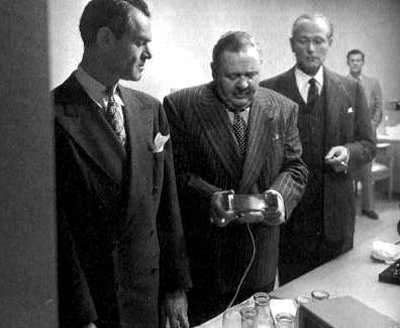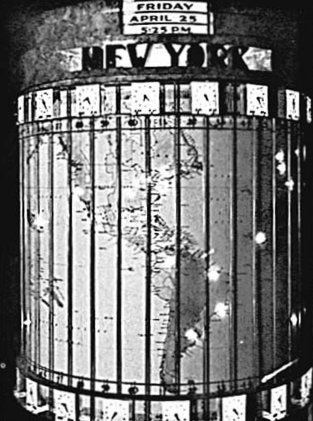 The Big Clock
The Big Clock (1948), an adaptation of Kenneth Fearing’s hardboiled gem directed by John Farrow, stars Ray Milland as George Stroud, an editor of a crime magazine that specializes in finding and exposing criminals that have eluded the police. Through a series of events as fantastic as they are entertaining, Stroud recognizes the “missing” murderer he is looking for is actually himself—and the new question is, Who is framing him, and why? As the clues pour in, and Earl Janoth (Stroud’s boss played by Charles Laughton) and his associate Steve Hagen (George Macready) keep pushing Stroud to finger the criminal, Stroud begins to suspect that their motivations aren’t entirely editorial. The plot is indicative of the Golden Age of mystery yarns: plots so rigorously convoluted they are admirable.
The Big Sleep (1946) is famous for featuring a murder that even the author of its original novel, Raymond Chandler, could not figure out. But
The Big Clock (as far as I can figure) makes sense—that said, there’s always someone’s mother, such as my own, who can find holes in any plot with such ease that it’s almost their sixth sense.

The trio of Milland, Laughton and Macready are remarkable together, and they are able to sustain an almost intolerable amount of tension, in large part due to the amount of restraint they bring to their roles. Instead of blowing gaskets and waxing hysteric, all three actors exert an unsettling sense of calm. Their anxiety does not emanate from sweaty brows, blundered speech and hasty decisions, but rather from their decisiveness in situations that would typically breed anything but. Elsa Lanchester, famous for playing
The Bride of Frankenstein (1935), plays a painter who gives a fair amount of comic relief to the film (a staple of the hardboiled genre). Finally, Margaret O’Sullivan plays Milland’s wife, Georgette Stroud, a character that is somewhat under-utilized, but is important in highlighting the less-flattering characteristics of Milland.

“The Big Clock” that the title refers to is a large tower in the middle of Stroud’s building:an Orwellian object that represents time, order, and logicality, it shows the exact time of every country in the world. It is the prized monolith of Earl Janoth, a man who likewise sees himself as a purveyor of dominion over his employees. Metaphorically, it belongs in the series of cinematic images of “Big Brother” and other panoptic structures. But culturally it belongs among the great, antiquated cinematic images of modernity along with
Metropolis (1927). Inside the clock, a spiral staircase leads to a platform with revolving cylinders and walls filled with rows and columns of flashing lights. While neither of which seem to have any mechanic function, they seem to be indicative (especially the blinking lights) of the movies’ preoccupation with futuristic technology. Nothing about the story suggests that it is to take place in the future, yet at the core of the story is this structure that is absolutely foreign to the present. The structure’s unfamiliarity is unrelenting, and it is the impossibility of familiarity that makes it so sinister. When Ray Milland is at the top of the clock, crouched behind a console as Henry Morgan (more familiarly credited as Harry Morgan of “Dragnet”) slowly ascends the stairs with his gun drawn, the clock’s design lends an atmosphere of desolation and hopelessness. Its disconnection from the offices that we work in is a source of anxiety that we draw on, and it feeds our connection with Ray Milland’s character. It is this attention to detail, along with impeccable acting, writing (by both Fearing and screenwriter Jonathan Latimer) and directing by Farrow that makes
The Big Clock such a strong film, one that stands alongside Frank Tuttle’s
This Gun for Hire (1942) as an example of the hardboiled film that does not degenerate over time into satire and caricature.
 The Big Clock (1948), an adaptation of Kenneth Fearing’s hardboiled gem directed by John Farrow, stars Ray Milland as George Stroud, an editor of a crime magazine that specializes in finding and exposing criminals that have eluded the police. Through a series of events as fantastic as they are entertaining, Stroud recognizes the “missing” murderer he is looking for is actually himself—and the new question is, Who is framing him, and why? As the clues pour in, and Earl Janoth (Stroud’s boss played by Charles Laughton) and his associate Steve Hagen (George Macready) keep pushing Stroud to finger the criminal, Stroud begins to suspect that their motivations aren’t entirely editorial. The plot is indicative of the Golden Age of mystery yarns: plots so rigorously convoluted they are admirable. The Big Sleep (1946) is famous for featuring a murder that even the author of its original novel, Raymond Chandler, could not figure out. But The Big Clock (as far as I can figure) makes sense—that said, there’s always someone’s mother, such as my own, who can find holes in any plot with such ease that it’s almost their sixth sense.
The Big Clock (1948), an adaptation of Kenneth Fearing’s hardboiled gem directed by John Farrow, stars Ray Milland as George Stroud, an editor of a crime magazine that specializes in finding and exposing criminals that have eluded the police. Through a series of events as fantastic as they are entertaining, Stroud recognizes the “missing” murderer he is looking for is actually himself—and the new question is, Who is framing him, and why? As the clues pour in, and Earl Janoth (Stroud’s boss played by Charles Laughton) and his associate Steve Hagen (George Macready) keep pushing Stroud to finger the criminal, Stroud begins to suspect that their motivations aren’t entirely editorial. The plot is indicative of the Golden Age of mystery yarns: plots so rigorously convoluted they are admirable. The Big Sleep (1946) is famous for featuring a murder that even the author of its original novel, Raymond Chandler, could not figure out. But The Big Clock (as far as I can figure) makes sense—that said, there’s always someone’s mother, such as my own, who can find holes in any plot with such ease that it’s almost their sixth sense. The trio of Milland, Laughton and Macready are remarkable together, and they are able to sustain an almost intolerable amount of tension, in large part due to the amount of restraint they bring to their roles. Instead of blowing gaskets and waxing hysteric, all three actors exert an unsettling sense of calm. Their anxiety does not emanate from sweaty brows, blundered speech and hasty decisions, but rather from their decisiveness in situations that would typically breed anything but. Elsa Lanchester, famous for playing The Bride of Frankenstein (1935), plays a painter who gives a fair amount of comic relief to the film (a staple of the hardboiled genre). Finally, Margaret O’Sullivan plays Milland’s wife, Georgette Stroud, a character that is somewhat under-utilized, but is important in highlighting the less-flattering characteristics of Milland.
The trio of Milland, Laughton and Macready are remarkable together, and they are able to sustain an almost intolerable amount of tension, in large part due to the amount of restraint they bring to their roles. Instead of blowing gaskets and waxing hysteric, all three actors exert an unsettling sense of calm. Their anxiety does not emanate from sweaty brows, blundered speech and hasty decisions, but rather from their decisiveness in situations that would typically breed anything but. Elsa Lanchester, famous for playing The Bride of Frankenstein (1935), plays a painter who gives a fair amount of comic relief to the film (a staple of the hardboiled genre). Finally, Margaret O’Sullivan plays Milland’s wife, Georgette Stroud, a character that is somewhat under-utilized, but is important in highlighting the less-flattering characteristics of Milland.  “The Big Clock” that the title refers to is a large tower in the middle of Stroud’s building:an Orwellian object that represents time, order, and logicality, it shows the exact time of every country in the world. It is the prized monolith of Earl Janoth, a man who likewise sees himself as a purveyor of dominion over his employees. Metaphorically, it belongs in the series of cinematic images of “Big Brother” and other panoptic structures. But culturally it belongs among the great, antiquated cinematic images of modernity along with Metropolis (1927). Inside the clock, a spiral staircase leads to a platform with revolving cylinders and walls filled with rows and columns of flashing lights. While neither of which seem to have any mechanic function, they seem to be indicative (especially the blinking lights) of the movies’ preoccupation with futuristic technology. Nothing about the story suggests that it is to take place in the future, yet at the core of the story is this structure that is absolutely foreign to the present. The structure’s unfamiliarity is unrelenting, and it is the impossibility of familiarity that makes it so sinister. When Ray Milland is at the top of the clock, crouched behind a console as Henry Morgan (more familiarly credited as Harry Morgan of “Dragnet”) slowly ascends the stairs with his gun drawn, the clock’s design lends an atmosphere of desolation and hopelessness. Its disconnection from the offices that we work in is a source of anxiety that we draw on, and it feeds our connection with Ray Milland’s character. It is this attention to detail, along with impeccable acting, writing (by both Fearing and screenwriter Jonathan Latimer) and directing by Farrow that makes The Big Clock such a strong film, one that stands alongside Frank Tuttle’s This Gun for Hire (1942) as an example of the hardboiled film that does not degenerate over time into satire and caricature.
“The Big Clock” that the title refers to is a large tower in the middle of Stroud’s building:an Orwellian object that represents time, order, and logicality, it shows the exact time of every country in the world. It is the prized monolith of Earl Janoth, a man who likewise sees himself as a purveyor of dominion over his employees. Metaphorically, it belongs in the series of cinematic images of “Big Brother” and other panoptic structures. But culturally it belongs among the great, antiquated cinematic images of modernity along with Metropolis (1927). Inside the clock, a spiral staircase leads to a platform with revolving cylinders and walls filled with rows and columns of flashing lights. While neither of which seem to have any mechanic function, they seem to be indicative (especially the blinking lights) of the movies’ preoccupation with futuristic technology. Nothing about the story suggests that it is to take place in the future, yet at the core of the story is this structure that is absolutely foreign to the present. The structure’s unfamiliarity is unrelenting, and it is the impossibility of familiarity that makes it so sinister. When Ray Milland is at the top of the clock, crouched behind a console as Henry Morgan (more familiarly credited as Harry Morgan of “Dragnet”) slowly ascends the stairs with his gun drawn, the clock’s design lends an atmosphere of desolation and hopelessness. Its disconnection from the offices that we work in is a source of anxiety that we draw on, and it feeds our connection with Ray Milland’s character. It is this attention to detail, along with impeccable acting, writing (by both Fearing and screenwriter Jonathan Latimer) and directing by Farrow that makes The Big Clock such a strong film, one that stands alongside Frank Tuttle’s This Gun for Hire (1942) as an example of the hardboiled film that does not degenerate over time into satire and caricature.

No comments:
Post a Comment